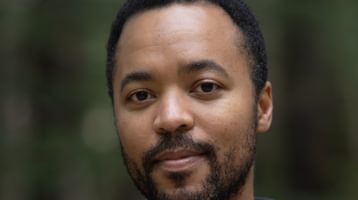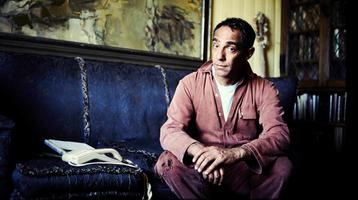
Michael Kurtz
Morgan Quaintance is neither a straight documentarian nor a pure structural filmmaker but something in-between. Often grounded in his personal experience, his films investigate specific social subjects, such as his Jamaican-born mother’s London youth or anti-racist movements in Chicago, while pulling apart the medium’s basic elements: light, sound and time.
Repetitions (2022) is no exception. On the surface, it consists of brief snippets of seemingly random footage taken by Quaintance over the last thirty years — leafless trees against a grey sky, feet walking up a staircase, MRI scans of his knee — and a fragmented soundscape of melancholy piano music, aggressive drumbeats and waves of noise. Tantalising moments of thematic clarity emerge within the 24-minute film’s opaque fabric, such as early-twentieth-century photographs of black feminist activists and a twenty-first-century speech about workers’ rights during the Covid pandemic.
More than any one image or theme, though, the work is defined by Quaintance’s editorial style, which refuses to let viewers settle into the cinematic illusion. Some clips are looped until even the most banal detail takes on a mysterious significance, while others are broken down into a few still frames that rock back and forth. ‘Juddering rhythmically’, as Huda Awan observes, the film seems to be taking ‘two steps forward, one step back’.1 Early on, for instance, a boy crouching on the pavement turns to the camera, his features emerging out of shadow. But Quaintance keeps shuffling the grainy black-and-white clip back, denying a prolonged view of the figure’s face and frustrating our desire for smooth forward motion.

Morgan Quaintance, Repetitions (2022), film still. Courtesy of the artist.
Soon after, the film switches to colour and the camera spins round a room filled with books and warm light, its dizzying movement punctuated by glimpses of faces and hands, while a piano begins to play a pattern of plaintive arpeggios. We hear a collection of answering machine messages to someone called Bella from concerned friends and disgruntled employees: “this is Ralph, I need for you to call me at the plant”; “Ruth again trying to catch up with you”; “Bella are you there?” The mix of sensory excitement (spinning camera, looping notes, increasingly speedy montage) and forlorn voice recordings creates a sense of inexplicable urgency: what is this room? who are these faces? where is Bella? am I Bella? am I needed at the plant? how do I answer? But the sequence ends as suddenly as it began, leaving these questions unanswered.
As well as a filmmaker and writer, Quaintance is a musician, and interactions between image and sound are central to his work. In Repetitions, although the two never come from the same source (we do not hear what we see), they feel causally related. This impression is primarily an effect of rapid looping: if an image repeats alongside the same audio enough times, however distinct the two may be, they seem to stem from one another. After a few cycles, even a still photograph can appear to ‘play’ a minor seventh chord or an abstract patch of blurry screen to produce its own spluttering crackle, as if the camera were a turntable stylus being dragged across the picture’s surface. In other sections, the audio mimics the subjects on screen; a click-clacking beat coincides with mute footage of railway tracks, and the pitter patter of static noise with rain falling into a puddle.
Halfway through the film an ascending line of piano chords begins to loop over details from a group photograph of black women wearing smart hats and coats, broaches and earrings, perhaps in mid-century America. Elegantly handwritten on the paper mount of her portrait, the name of Mary Church Terrell, an activist who died in 1954, flickers across the screen, while a voice explains: “you click on browse and then click on archival collections”. With the same notes still rising, a recording plays of a woman demanding better conditions for transport workers in Illinois during the Covid pandemic. “We tired of y’all giving us these commemoration pens”, she asserts, “hazard pay is what people need…” This sequence links two episodes in the history of US civil rights protest, illustrating the slow iterative nature of struggles for justice and echoing in macro the film’s looping structures. There is more to Quaintance’s treatment of socio-political material, though, than mere affinity between form and content.

Morgan Quaintance, Repetitions (2022), film still. Courtesy of the artist.
In recent decades, critical race theorists have sought to approach photographic archives of marginalised people not as fixed bodies of evidence but opportunities to reanimate history and trace overlooked subaltern agency. Ariella Azoulay recommends ‘watching’ rather than ‘looking’ at photos because the verb, evoking ‘dimensions of time and movement’, suggests the subject is still present and so implies an ‘attempt to respond to the photographed figure’.2 Tina Campt, meanwhile, proposes ‘listening’ to images as a way of challenging ‘the equation of vision with knowledge by engaging photography through a sensory register that is critical to Black Atlantic cultural formations: sound’.3 Methodological metaphors aside, these writers attend to the contingent details and material qualities of photographs in order to enter a dialogue with the past. ‘Watching’ portraits of activists, for example, we might ask not only what they did or what happened to them but also how we are implicated in their story.
Repetitions embodies this archival approach in cinematic form. Its primary motif is the interpenetration of past and present, and instead of outlining a predetermined historical narrative, it stages a visceral encounter between audience and image. Through tense crescendos of light and sound, jolting cuts and loops, wistful pauses and sudden flashes of noise, we experience hope and anticipation, pleasure and fatigue, and become implicated in the film’s world. We are watching, listening to, dancing with images, as if representing another episode in the work’s hundred-year lineage, another speaker in its intergenerational conversation. We will the images on — to speed up, move forward, become clear! — and they make demands of us in turn: ‘hazard pay is what people need’ … don’t look away … ‘are you there?’
1 Huda Awan, ‘Forever Prisoner? New Works by Morgan Quaintance’, Open City Documentary Festival Notes (September 2023).
2 Ariella Azoulay, The Civil Contract of Photography (New York: Zone Books, 2008), 12-16.
3 Tina M. Campt, Listening to Images (Durham: Duke University Press, 2017), 6.
Michael Kurtz is an art critic based in London. He writes regularly for publications including Art Monthly, e-flux Criticism and ArtReview, and won the International Award for Art Criticism in 2023.



